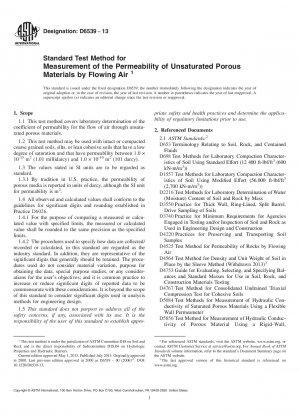ASTM D6539-13
Standard Test Method for Measurement of the Permeability of Unsaturated Porous Materials by Flowing Air
- Standard No.
- ASTM D6539-13
- Release Date
- 2013
- Published By
- American Society for Testing and Materials (ASTM)
- Latest
- ASTM D6539-13
- Scope
4.1 This test method applies to the one-dimensional laminar (viscous) flow of air in porous materials such as soil.
Note 1—This test method deals with porous materials with both gaseous (air) and liquid (pore water) mobile fluids: The liquid phase is much less compressible, has a higher viscosity, and is much more tightly bound to the solid phase by chemical forces. The assumption of single-phase flow may still be presumed to be valid since the test gradient ensuring the conditions of laminar flow may be low enough that flow of the liquid phase is negligible.4.2 The degree of saturation of the specimen shall be less than that which would produce significant internal transport of pore water or alter the continuity of air voids under the applied gradients. The maximum permissible degree of saturation must be evaluated by an experienced analyst. In no instance shall the specimen be so saturated that pore water appears at the exit of the permeameter cell during the test.
4.3 This test method is based on the assumption that the rate of mass flow through the specimen is constant with time.
Note 2—When a specimen contains volatile materials this assumption is violated. The mass of gas flowing out will be greater than that flowing in, the gradient cannot be determined and the test may become meaningless. Such specimens pose special problems and must be decontaminated before analysis in order to minimize health and safety concerns and to prevent contamination of the test apparatus.4.4 The permeability of porous materials may be strongly dependent on a variety of physical properties including the void ratio, the degree of saturation, and percent and direction of compaction. It is beyond the scope of this test method to elaborate upon these dependencies. Rather, this test method is intended to be a measurement technique for determining the permeability under a certain set of laboratory conditions. It is the responsibility of the test requestor to specify which soil parameters must be controlled to ensure a valid extension of the test results to field conditions.
4.5 Calculation of the permeability using Darcy’s law requires laminar flow conditions through the soil specimen. The conditions for laminar flow shall be evaluated by plotting the volumetric flow rate of air through the specimen against the pressure drop across the specimen. If the individual test points lie within 25 % of a straight line passing through the origin, then laminar flow conditions are present and Darcy's law may be used to calculate the permeability.
Note 3—The permeability calculated using this standard is valid only when the degree of saturation does not change over time. Long measurement times associated with the use of bubble meters and manometers may indirectly lead to variability when measuring flow versus pressure drop (see 8.2) due to evaporation. The recommended use of digital electronic flow and pressure sensors leads to considerably reduced measurement times because the user can quickly determine by inspection when a steady state......ASTM D6539-13 Referenced Document
- ASTM D1557 Standard Test Methods for Laboratory Compaction Characteristics of Soil Using Modified Effort (56,000 ft-lbf/ft3 (2,700 kN-m/m3))
- ASTM D2216 Standard Test Method for Laboratory Determination of Water (Moisture) Content of Soil and Rock by Mass
- ASTM D3550 Standard Practice for Thick Wall, Ring-Lined, Split Barrel, Drive Sampling of Soils
- ASTM D3740 Standard Practice for Minimum Requirements for Agencies Engaged in the Testing and/or Inspection of Soil and Rock as Used in Engineering Design and Construction
- ASTM D4220 Standard Practices for Preserving and Transporting Soil Samples
- ASTM D4525 Standard Test Method for Permeability of Rocks by Flowing Air
- ASTM D4564 Standard Test Method for Density of Soil in Place by the Sleeve Method
- ASTM D4753 Standard Specification for Evaluating, Selecting, and Specifying Balances and Scales for Use in Soil, Rock, and Construction Materials Testing
- ASTM D4767 Standard Test Method for Consolidated Undrained Triaxial Compression Test for Cohesive Soils
- ASTM D5084 Standard Test Methods for Measurement of Hydraulic Conductivity of Saturated Porous Materials Using a Flexible Wall Permeameter
- ASTM D5856 Standard Test Method for Measurement of Hydraulic Conductivity of Porous Material Using a Rigid-Wall, Compaction-Mold Permeameter
- ASTM D6026 Standard Practice for Using Significant Digits in Geotechnical Data
- ASTM D653 Standard Terminology Relating to Soil, Rock, and Contained Fluids
- ASTM D698 Standard Test Methods for Laboratory Compaction Characteristics of Soil Using Standard Effort (12 400 ft-lbf/ft3 (600 kN-m/m3))
- ASTM E1 Standard Specification for ASTM Thermometers
- ASTM E145 Standard Specification for Gravity-Convection And Forced-Ventilation Ovens
- ASTM E2251 Standard Specification for Liquid-in-Glass ASTM Thermometers with Low-Hazard Precision Liquids
ASTM D6539-13 history
- 2013 ASTM D6539-13 Standard Test Method for Measurement of the Permeability of Unsaturated Porous Materials by Flowing Air
- 2006 ASTM D6539-00(2006)e2 Standard Test Method for Measurement of Pneumatic Permeability of Partially Saturated Porous Materials by Flowing Air
- 2000 ASTM D6539-00(2006)e1 Standard Test Method for Measurement of Pneumatic Permeability of Partially Saturated Porous Materials by Flowing Air
- 2000 ASTM D6539-00(2006) Standard Test Method for Measurement of Pneumatic Permeability of Partially Saturated Porous Materials by Flowing Air
- 2000 ASTM D6539-00 Standard Test Method for Measurement of Pneumatic Permeability of Partially Saturated Porous Materials by Flowing Air

Copyright ©2024 All Rights Reserved